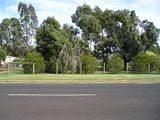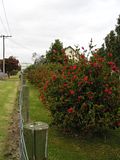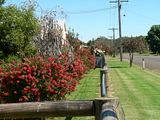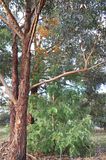What would be the best options for a screening hedge type plant that grows to about 3m and doesn’t require a lot of maintenance?
poik, my favourite is red bottle brushes (Callistemon). I’ve done a long informal hedge at Casterton with them. It’s now about 10 or more years old and probably around 8ft tall.
In the beginning it looked like this:
And then a few years ago it had improved to this:
Early on, and when not in flower:

You do need to be willing to prune all the old flower heads off for the first 5 or 6 years at least to get them nice and bushy. Now I just hack along with the hedge pruners when they get too close to the fence and I can’t get the mower along there without a fight. Actually, looking at those pictures, I really need to do another photo now that they have spread to the fence too.






